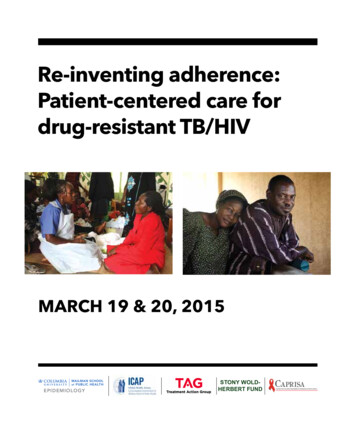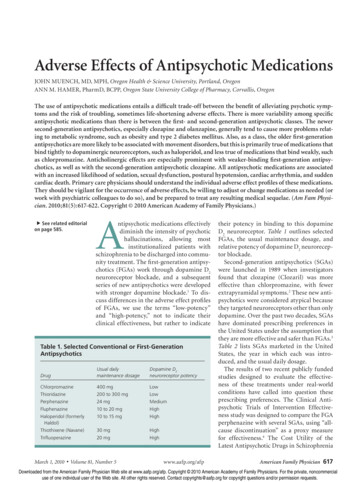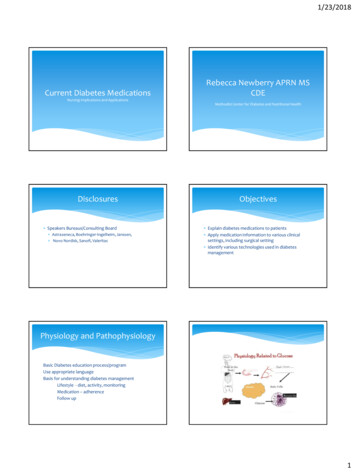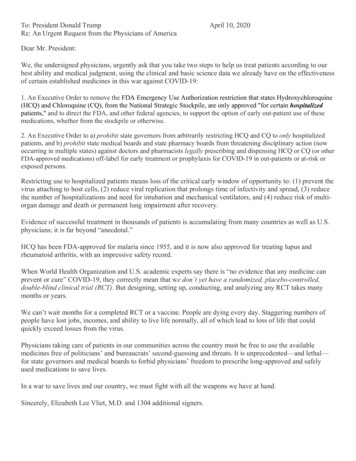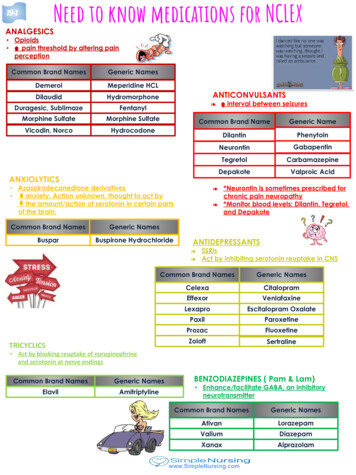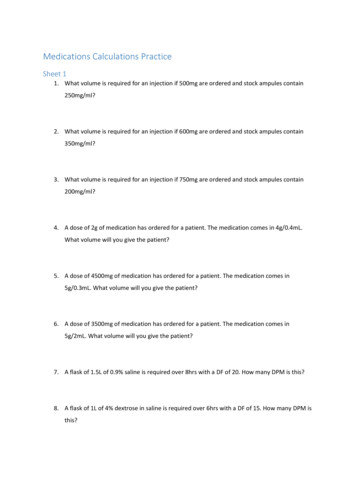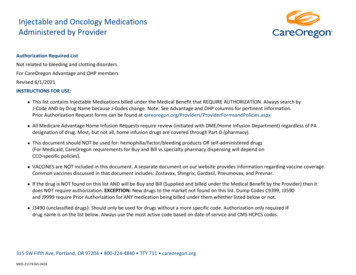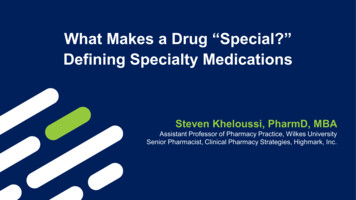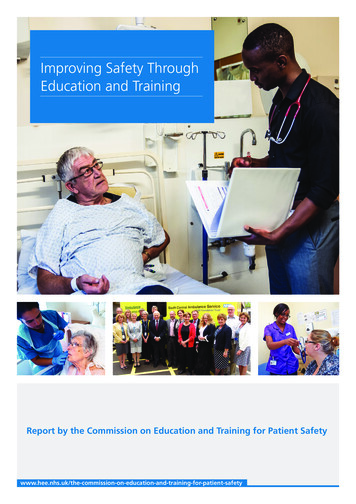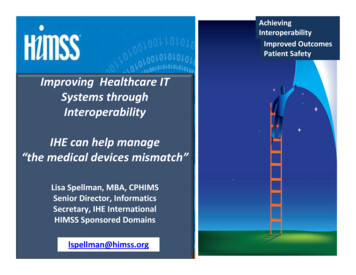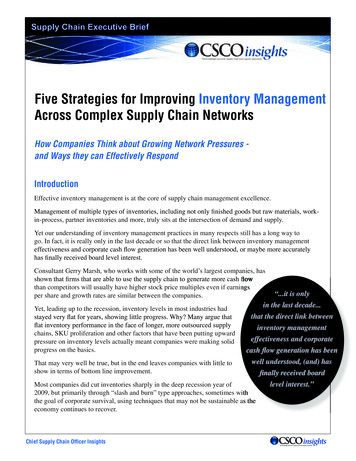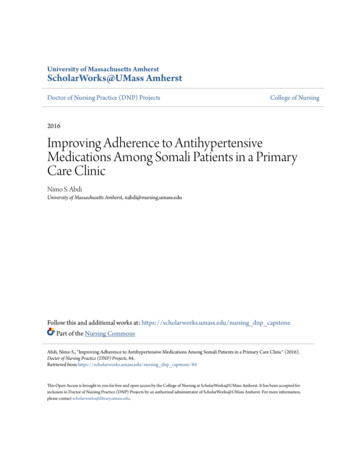
Transcription
University of Massachusetts AmherstScholarWorks@UMass AmherstDoctor of Nursing Practice (DNP) ProjectsCollege of Nursing2016Improving Adherence to AntihypertensiveMedications Among Somali Patients in a PrimaryCare ClinicNimo S. AbdiUniversity of Massachusetts Amherst, nabdi@nursing.umass.eduFollow this and additional works at: https://scholarworks.umass.edu/nursing dnp capstonePart of the Nursing CommonsAbdi, Nimo S., "Improving Adherence to Antihypertensive Medications Among Somali Patients in a Primary Care Clinic" (2016).Doctor of Nursing Practice (DNP) Projects. 84.Retrieved from https://scholarworks.umass.edu/nursing dnp capstone/84This Open Access is brought to you for free and open access by the College of Nursing at ScholarWorks@UMass Amherst. It has been accepted forinclusion in Doctor of Nursing Practice (DNP) Projects by an authorized administrator of ScholarWorks@UMass Amherst. For more information,please contact scholarworks@library.umass.edu.
Running head: IMPROVING ADHERENCE TO ANTIHYPERTENSIVE MEDICATIONS1Improving Adherence to Antihypertensive Medications Among Somali Patients in a Primary Care ClinicNimo AbdiUMass College of Nursing
Running head: IMPROVING ADHERENCE TO ANTIHYPERTENSIVE MEDICATIONSCapstone Chair:Dr. Pamela AseltonCapstone Committee Member:Dr. Raeann LeBlancCapstone Mentor:Vasumathi NallusamyDate of Submission:April, 30th, 20152
IMPROVING ADHERENCE TO ANTIHYPERTENSIVE MEDICATIONS3AcknowledgementsBy the grace of God, I have made it this far and I cannot thank you enough. I would like to acknowledge and thank Dr. PamelaAselton, Dr. Raeann LeBlanc, Dr. Jean DeMartinis and my capstone mentor Vasumathi Nallusamy for their support and guidancethroughout this project and journey. I would love to thank all my family and friends for their unwavering love and support. Thank youall for assisting me to reach this milestone in my academic career.
IMPROVING ADHERENCE TO ANTIHYPERTENSIVE MEDICATIONSTable of ContentsAbstract .6Introduction and Background .7Problem Statement .9Review of the Literature .9Theoretical Framework .13Setting and Resources .16Sample.17Project Design and Methods .18Data Collection .19Organizational Analysis of project site 19Goals, Objectives and Expected Outcomes .20Ethics and Human Subjects Protection .21Materials .22Educational Intervention .22Results, Data Analysis and Interpretation .244
IMPROVING ADHERENCE TO ANTIHYPERTENSIVE MEDICATIONSDemographic Characteristics .24Data Analysis .25Statistical Analysis .26Qualitative Data .33Discussion .35Limitations .38Implications for Practice .38Conclusion .39References .41Appendix .485
IMPROVING ADHERENCE TO ANTIHYPERTENSIVE MEDICATIONS6AbstractPurpose: To evaluate if the use of an evidenced-based educational program delivered to adult Somali hypertensive participants at acommunity-based clinic in Minneapolis can improve their adherence to antihypertensive medications and blood pressure control.Methods: A convenient sample of 10 participants who met the inclusion criterion consented to take part of the educational program.The Hill-Bone Compliance to High Blood Pressure Therapy Scale was utilized to measure outcomes of the program. In addition tothat, each participant’s blood pressure was checked at pre and post intervention. Results: The statistical test of paired t-test was used toanalyze data. The pre intervention scores had a mean of 21. 80 (SD 1.55) and the post intervention scores had a mean of 18.30(SD 1.32). The correlation between pre and post scores was 0.44 (P 0.21). The mean differences between pre and posttest scoreswere 3.50 (SD 4.86). The resulting t-value with 9 degrees of freedom is 2.28, p 0.05. There was no statistical difference foundbetween pre and post intervention scores and BP measurements. Conclusion: Hypertension is known to be a silent killer and pooradherence to blood pressure medications and treatment therapy is a major risk for cardiovascular diseases and stroke. Even though theoutcome of the educational program did not seen a significant change in such a short time, there is a possible lasting effect of theeducation in the long run. A culturally appropriate educational program that is employed using oral communication, storing telling orvisual images has the potential to make a profound change both in the individual and within the community.Keywords: Hypertension, non-adherence, medication, antihypertensive
IMPROVING ADHERENCE TO ANTIHYPERTENSIVE MEDICATIONS7Introduction and BackgroundApproximately 68 million American adults aged 18 years or older have hypertension (HTN), which corresponds with 31 % ofthe total population (Yoon, Gillespie, George, & Wall, 2012). Hypertension is the most common risk factor for cardiovascular disease(CVD), surpassing diabetes mellitus, obesity, dyslipidemia, and smoking, and accounts for 49% of the risk of coronary heart disease,and 62% of stroke risk (American Heart Association, 2013 & Mackay, Mansah, Mendis, & Greenlund, 2004). Additionally, the riskfor CVD doubles for every 10mmHg increase in diastolic blood pressure or for every 20mmHg increase in systolic blood pressure(Mackay et al., 2004). Despite the clinical efficacy of antihypertensive medications to control blood pressure (BP), adherence tomedication treatment is poor and remains complex in the primary care settings.Approximately half of all hypertensive patients in the nation are non-adherent to their treatment regimen (Rash, Lavoie,Feldman, & Campbell, 2014). Recognizing barriers to medication adherence is a critical factor and remains a key challenge forclinicians everywhere. According to Rash et al., (2014), barriers to antihypertensive medication adherence consists of many factorsthat are related to patients, providers, therapy and the health care system. Examples of patient related factors include beliefs aboutmedication, motivation and mental health. Lack of patient-provider communication and failure to appropriately escalate treatment areexamples of provider related factors. Hypertension as being an asymptomatic disease, side effects and the complexity of regimens areexamples of therapy related factors. Medication cost, health literacy and uncoordinated delivery of services are all examples of systemrelated barriers to antihypertensive medication.
IMPROVING ADHERENCE TO ANTIHYPERTENSIVE MEDICATIONS8Minnesota is home to the largest population of Somali immigrants in North America (MN Measurement, 2014). A communitybased clinic in Minnesota is challenged with improving adherence to antihypertensive medications to a majority of the patients theymanage. Most of the patients who seek primary care services at the clinic are Somali immigrants. A small study of Somali psychiatricpatients in the United States found a high prevalence of diabetes and hypertension compared with non-Somali patients (Kinzie et al.,2008). Somalis, like most immigrants face many barriers utilizing the health care system. These barriers include language andcommunication, cultural beliefs and access to health care. In addition to barriers, this population is most likely to experience poorhealth literacy. Baur & the U.S. Department of Health and Human Services (2010) identified populations that are most likely toexperience limited health literacy as the following: adults over the age of 65 years; racial and ethnic groups other than White; recentrefugees and immigrants; people with less than a high school degree or GED; people with incomes at or below the poverty level; andnon-native speakers of English.Health literacy is known to play an important role in determining the health outcomes of individuals. Healthy People 2010defined health literacy as “the degree to which individuals have the capacity to obtain, process and understand basic healthinformation and services needed to make appropriate health decisions.” They have difficulty obtaining, understanding andimplementing health information; therefore they have a higher risk of poorer health outcomes. Wångdahl, Lytsy, Mårtensson, &Westerling (2014) investigated health literacy among refugees in different subgroups in Sweden. Among the refugees were Somalis,who were found to have inadequate or limited functional health literacy and comprehensive health literacy. The researchers found thatlow education and/or being born in Somalia was one of the key factors associated with their increased risk of having inadequate health
IMPROVING ADHERENCE TO ANTIHYPERTENSIVE MEDICATIONS9literacy. According to a 2014 MN Community Measurement report, Somalis have the poorest health-care outcomes rates among allMinnesota minorities. For example, in vascular care, patients who indicated Somali as their preferred language had the lowest optimalcare rate at 37 percent. This rate was significantly below the statewide average. Most data specific to the Somali population is difficultto elucidate because their biographic information is usually collected under ethnic minority, non-Hispanic Black or AfricanAmerican/Black.Problem StatementThe risk of HTN related complications such as stroke, heart failure, and renal failure among hypertensive adult Somali patientsis associated with the high rate of uncontrolled BP readings at a local primary care clinic in Minneapolis resulting from pooradherence to BP medications and lifestyle modifications. Personal health behaviors, cultural ramifications, beliefs and educationallevels can be varied and thus can have an effect in adherence to antihypertensive medications and treatment. Nevertheless, improvingadherence to BP medications is an important aspect of successful HTN self-management and prevention from complications.Implementation of evidenced-based practice that support educational interventions and self-monitoring of BP is intended to improvemedication adherence.Review of the LiteratureA comprehensive search of the literature for interventions that improve adherence to BP control include the followingdatabases: Cochrane and PubMed of the National Library of Medicine. The following Medical Subject Headings (MeSH) terms wereused for both Cochrane and PubMed search: adherence to antihypertensive medications and interventions to improve adherence and
IMPROVING ADHERENCE TO ANTIHYPERTENSIVE MEDICATIONS10antihypertensive medications. Inclusion criteria included English-language peer-reviewed publications, randomized controlled trials(RCTs) of interventions to improve adherence to antihypertensive medications, and articles that were published from 2007 to 2014. Atotal of 30 articles were found from Cochrane database, and total of 13 articles from PubMed. After a detail review of the articles, atotal of seven articles were chosen for review based on their fit with the project and quality of the review.In the seven articles chosen for review, six are randomized controlled trials and one is a meta-analysis review. Of the sixRCTs, two evaluated use of tailored behavioral/educational interventions targeting patient related factors and four evaluated uses ofelectronic systems to improve adherence and BP control, and one meta-analysis review evaluated the cost effectiveness ofinterventions.Tailored Behavioral/Educational Interventions modelBosworth et al. (2008) confirmed that nurse-administered interventions that are tailored to target HTN relatedbehaviors/education improve adherence to medications and BP control. Using a randomized controlled trial involving 636hypertensive patients from two outpatient primary clinics, the nurse-administered behavioral intervention group received a tailoredbehavioral intervention bi-monthly for two years via telephone and patient factors were targeted. The results showed that frombaseline to six months, self-reported medication adherence increased by 9% in the behavioral group versus only 1% in the nonbehavioral.In another study, Bosworth and colleagues (2009) conducted a similar randomized trial using the same sample size to testwhether patients receiving a combination of interventions that consisted of a tailored behavioral telephone intervention (bimonthly
IMPROVING ADHERENCE TO ANTIHYPERTENSIVE MEDICATIONS11nurse-administered targeting hypertension related behaviors), and home BP monitoring (three times weekly) would adhere and havebetter BP control than the patients in the usual care or those receiving only one intervention. Over a 24-month period, the researchersfound that the combined intervention group had the most increase in the proportion of patients with BP control. Both studies signifiedconsistent findings that the implementations of tailored behavioral interventions are effective in improving adherence and BP control.Furthermore, these interventions are feasible to implement in the primary care settings.Using Electronic Systems to Improve Adherence and BP controlThe use of electronic systems such as the medication reminder software helps improve medication adherence and BP control(Patel et al., 2013). By recruiting 50 high-risk urban adults with HTN from the internal medicine, renal/hypertension, and cardiologyclinics of the George Washington University Medical faculties, Patel et al. (2013), evaluated if medication reminder software on amobile phone can improve adherence and BP control. By reviewing pharmacy refill rates before, during, and after availability of themedication reminder software, the researchers found a significant difference between the activation and post-activation phases (p .001).In addition, other studies have shown that the use of other electronic monitoring devices such as the Medication EventMonitoring System (MEMS) may help improve medication adherence and BP control (Santschi, Rodondi, Bugnon, & Burnier, 2008;& Wetzels et al., 2007). This monitoring system is a pillbox that is equipped with a microchip in its lid and registers the date and timewhenever the lid is open. In a five-month study period, Wetzels et al. carried out a randomized control study using a sample of 258
IMPROVING ADHERENCE TO ANTIHYPERTENSIVE MEDICATIONS12hypertensive participants. Patients in the intervention group were supplied with MEMS and the investigators found that 50.6% of thepatients in the control group reached adequate BP compared to 53.7% in the intervention group.Santschi, Rodondi, Bugnon, & Burnier (2008) conducted a study using the MEMS electronic monitoring device incollaboration with community pharmacists and general practitioners in a 12-month clustered randomized trial. The researchers foundthat at four-months, the systolic BP was significantly lower in the electronic monitoring group compared to the usual care group. In amore recent study, involving 398 participants over a six-month period, Christensen and colleagues (2010) found that patients using theelectronic monitoring reported 91% compliance versus 85% in the control group. However, this difference diminished over time (88%versus 86%) and BP was not affected. The researchers concluded that this intervention was more suitable in newly diagnosedhypertensive patients and in those who have a tendency to forget taking their medications.In a meta-analysis review, Chapman and colleagues (2010) evaluated adherence intervention studies in order to compare thecost effectiveness of different interventions that have shown to improve adherence with antihypertensive therapy and lipid-loweringmedications. After screening twenty-three adherence-improving studies, the researchers found that self-monitoring, reminder andeducational materials, and a pharmacist/nurse management program were found to be cost-effective and should be considered beforeother interventions. The researchers used an analytic framework and they were able to adjust for the different levels of adherence thatare often seen in the real world. The researchers concluded that educating the patient is a key component of cost effective interventionalthough adherence tends to decrease over time.
IMPROVING ADHERENCE TO ANTIHYPERTENSIVE MEDICATIONS13As stated by Bosworth et al. (2009), improving adherences to HTN medications requires a holistic approach consisting ofeducational interventions, behavioral interventions and self-monitoring of BP. Within this realm, an intervention that has ultimatecapacity for augmenting the adherence to BP medications respective to the Somali patients requires comprehensive and multifacetedapproach. The essences of achieving these fundamental steps can be facilitated by a bilingually skilled person, which the DNP studentpossesses. The Somali patients prefer to be advised and supervised by someone whose language and cultural upbringings is quitesimilar to their own. Employing educational interventions, and self-management of HTN are effective and inexpensive methods toimplement in the clinical setting (Chapman et al., 2010). An educational program offered in smaller class-bases, self-monitoringdemonstrations in terms of monitoring BP, and teaching about the disease process including cultural foods high in sodium vs. low saltdiet translated into their native language are all conducive for improving adherence of BP medication to Somali hypertensive patients.Theoretical FrameworkOrleans (2008) reports that being non-adherence to prescribed medical screening, prevention and disease managementpractices are considered to be the four leading behavioral risks factors. This is often seen in low-income and disadvantaged racial andethnic populations, and in low resources communities. Chronic conditions such as HTN require both immediate behavior change andlonger-term behavior maintenance. Therefore, the use of the Health
ScholarWorks@UMass Amherst Doctor of Nursing Practice (DNP) Projects College of Nursing 2016 Improving Adherence to Antihypertensive Medications Among Somali Patients in a Primary Care Clinic Nimo S. Abdi University of Massachusetts A
